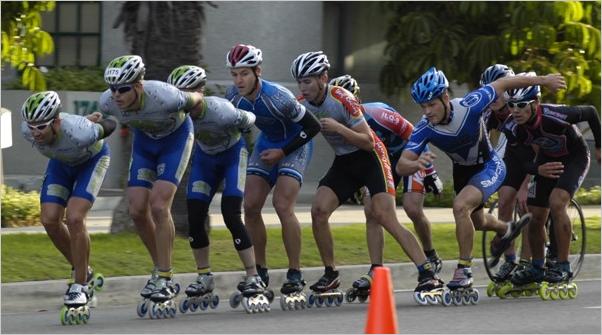This week's tip:
How to Skate in a Pack
Rules for Drafting, Pulling and Otherwise Keeping Peace in the Paceline

Simmons' Adam Miller (third from right) goes on a flyer during the 2005 Long Beach Inline Marathon. (photo: Ken Cleaver)
By Cale Carvell
Pack skating can be a little intimidating. But once you experience its benefits and learn its rules, you’ll never want to race solo again.
The benefit of pack skating is drafting. When you skate behind someone, you are in his or her draft. As a result, you don’t have to push through the air and you save energy.
Drafting isn’t unique to skating. It’s also part of cycling, Nascar racing and even running.
The skater in front of the pack — the one who is “pulling” — is expending 20 percent more energy than the skaters in the draft. Obviously, this makes it much easier for the skaters in the pack to maintain their speed and conserve energy. And if they are smart, they can use this extra energy at the end of the race to fuel their sprints.
Rules for pack skating
When you skate in a pack, certain things are expected of you by the fellow skaters:
Pulling
You are under no obligation to take a turn pulling the pack. But if you are in a group of skaters of similar level, you should be ready to take your turn when you become second in line.
Effort
You are under no obligation to skate your hardest when you are in front, pulling the pack. But you should maintain a comfortable pace that does not slow the pack too much (unless it is your intention to help a teammate who is out on a breakaway.)
Out of gas
If you are tired and struggling to stay with the pack, you can take a short pull and move to the side so the next skater can take over.
Getting back in the pack
After taking a pull, stand up and move to the side. Maintain your speed and look for a chance to get back into the line. Often, one of the skaters will signal you to get in front of him or her. Make eye contact with each skater that passes until this happens.
Placement
Remember that if you get back into the pack near the front, your turn to pull will come around that much sooner. Usually, it is a good idea to join the pack towards the back so you have more time before your next pull.
Letting skaters in
When you are in a pack, it’s usually a good idea to let skaters in in front of you. In that way, there will be another skater in front of you to take a pull.
Pushing the pace
If you feel you are one of the strongest skaters in the pack, you may want to get in front and go as hard as you can in hopes of dropping some of the weaker skaters. This can reduce the number of skaters you have to contend with in the final sprint.
Going on a flyer
Another tactic to thin the pack is to hang back in the pack out of sight. And then, when the pack slows down, step out and start sprinting as hard and as long as you can. This is called going on a flyer. Usually, some or all of the skaters in the pack will give chase. But often, you can drop some of them.
Breakaways
When you are joined on your flyer by a few other skaters, you can work collaboratively by taking fast, short pulls. In this way, you may be able to move further ahead of the chase pack.
Contact
Due to the effect of drafting, you will sometimes find yourself moving close to the back of the skater in front of you. This often happens when you are going downhill or when you are trying to catch a flyer or when the front skater speeds up.
The proper technique when you get close to the skater in front of you is to put one hand — one hand only — on the small of his or her back. This will maintain your distance and slow you down. It is a good idea to say “pushing” before you place your hand so the skater is not startled. Never grab the skater’s uniform, water bottle or body. Doing so could cause a fall, which could be a disaster in a large pack.
Stroke
The most efficient way to skate in a pack is to match your stroke with that of the skater in front of you. This allows you to skate close to the skater and maximizes the effect of drafting.
Last man out
Try not to be the last skater in the pack. There is an accordion effect in a pack. The front starts moving before the back and the further back you are, the longer it takes you to react to what’s going on in the front. Another problem with being last in the pack is what it does to your mind. It has a negative psychological effect that makes it easier to give up when you are tired.
Pack skating has a learning curve. But just remember, you’re always better off in the pack than out of it. The amount of energy you save is enormous. And besides, it's more fun to share the race with a crowd.
Of course, when you get close to the finish line, it’s every man for himself. So sprint your fastest and don’t forget to raise your hands in the air when you win!
 Cale Carvell is a former professional tennis player, competitive hockey player and one of America’s top grand veteran inline racers. He grew up in his father’s ice skating rink and tennis club in Chicago and later took over the sporting goods end of the business and was one of the first inline skate dealers in the nation. He was an early sponsor of the Northhore Inline Marathon and the founder of the Team Rainbo skate club. He won this year’s pro grand veteran division in the National Roller Cup and has won his division at the Northshore four times in the last five years. At 62, he is still racing, promoting and sharing his passion for inline skating.
Cale Carvell is a former professional tennis player, competitive hockey player and one of America’s top grand veteran inline racers. He grew up in his father’s ice skating rink and tennis club in Chicago and later took over the sporting goods end of the business and was one of the first inline skate dealers in the nation. He was an early sponsor of the Northhore Inline Marathon and the founder of the Team Rainbo skate club. He won this year’s pro grand veteran division in the National Roller Cup and has won his division at the Northshore four times in the last five years. At 62, he is still racing, promoting and sharing his passion for inline skating.